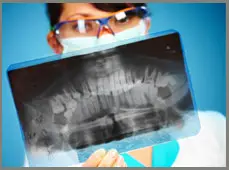Dental x-rays have gotten a bad rap this year and a lot of people are asking, “Are x-rays really necessary?”
The answer is yes. Dental x-rays are used for diagnosing and treating problems that can’t be seen with the naked eye. X-rays reveal cavities between the teeth or hidden by fillings, infections in the bone, fractures, gum disease, abscesses, cysts, and tumors.
“If a patient is in pain, there’s no way for us to diagnose without an x-ray,” said Marina Mikhalets-Fasbinder, DDS, a family dentist in the Coast Dental Plantation office in Plantation, Florida. “Plus, x-rays give us a baseline so we can track changes in your oral health.”
In Florida, state regulations require dentists to perform an oral exam on a patient at least once every 13 months, and professional standards of dentistry include x-rays as part of the exam.
Dr. Mikhalets has worked in dentistry for 20 years. In that time, there have been amazing technological advancements in x-rays. Many Coast Dental offices offer digital radiography, which reduces radiation by as much as 80 percent. Our other offices use improved x-ray film, so less exposure is needed to get clear images. Plus, all of our offices use lead-lined aprons to cover the patient from the neck to the knees, and thyroid collars are available too, which the American Dental Association recommends for pregnant women and children.
A study published this past April in the journal Cancer reported that people with the most common type of benign brain tumors, meningiomas, were more likely to report they had certain dental x-rays in their lifetimes. The American Dental Association![]() disputes the findings, noting that the results relied on the individuals’ memories of having dental x-rays taken decades earlier. Then popular TV talk show host Dr. Oz said there may be a link between dental x-rays and thyroid cancer, which the New York Times reviewed and discussed in an article called, “Thyroid Fears Aside, That X-Ray’s Worth It.”
disputes the findings, noting that the results relied on the individuals’ memories of having dental x-rays taken decades earlier. Then popular TV talk show host Dr. Oz said there may be a link between dental x-rays and thyroid cancer, which the New York Times reviewed and discussed in an article called, “Thyroid Fears Aside, That X-Ray’s Worth It.”![]()
So how much radiation do dental x-rays have?
About the same amount as eating 50 bananas.
That’s right. A banana contains 0.1 microsieverts, which is the standard measure of the biological effect of radiation.
Dental x-rays have 5 microsieverts of radiation. Flying just once from New York to LA exposes you to 40 microsieverts. Living in a brick or concrete house for a year exposes a person to 70 microsieverts. And you get about 400 microsieverts a year from food. What regularly-prescribed diagnostic test has 4,000 microsieverts? Check this chart ![]() to find out.
to find out.
“When patients raise fears about getting the x-rays, I remind them that they get more radiation from the sun then they do from dental x-rays,” said Paulette Exile. a registered dental hygienist at Coast Dental Plantation who has more than 20 years of experience. “We need just six x-rays once a year for an oral exam, and a set of full-mouth x-rays every three years, unless the patient is in pain. But there’s no way for dentists to diagnose the problems they can’t see with the naked eye unless we have the x-rays.”
Reviewed by: Marina Mikhalets, DDS
Reviewed by: Paulette Exile, RDH
Reviewed by: Cindy Roark, DMD
